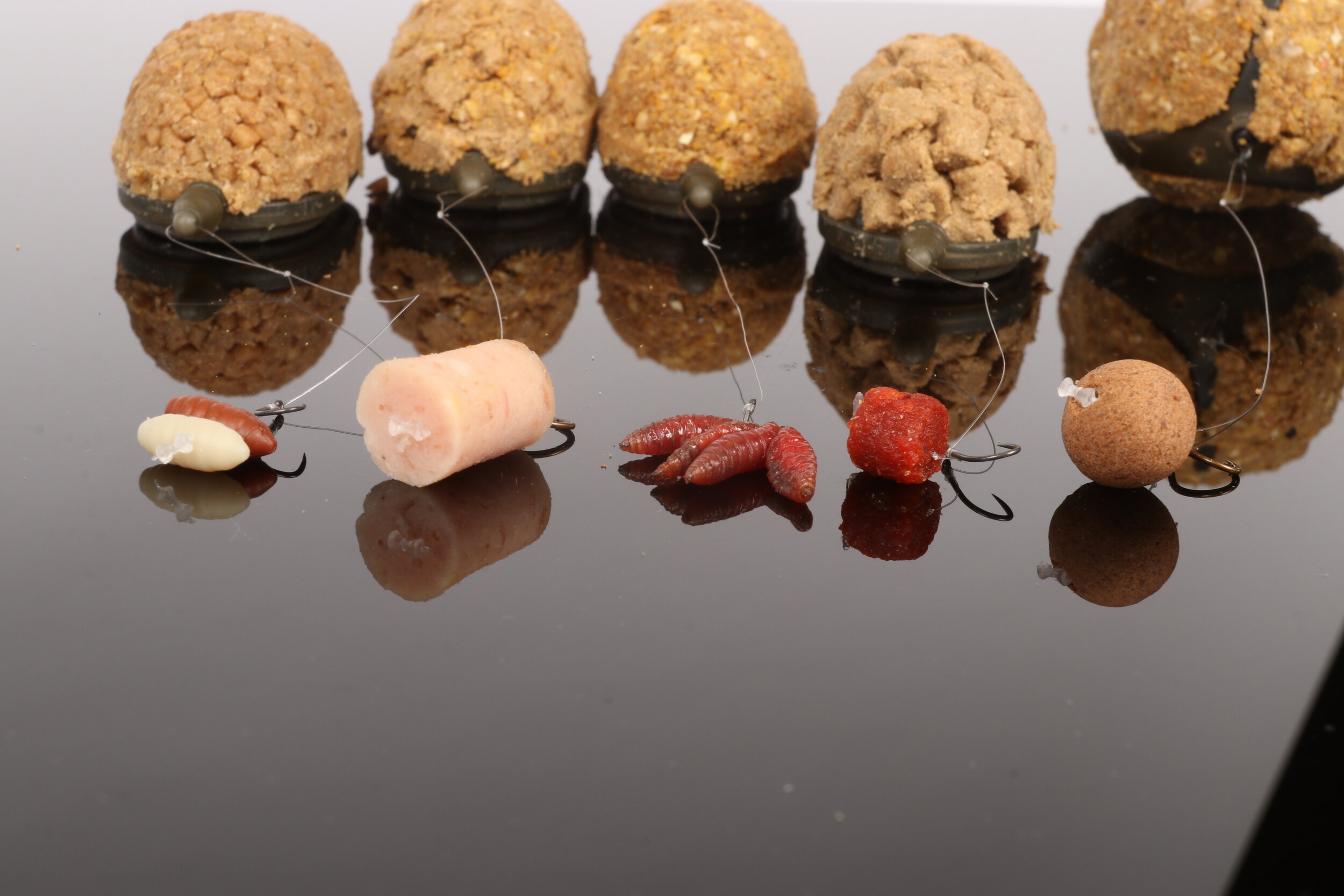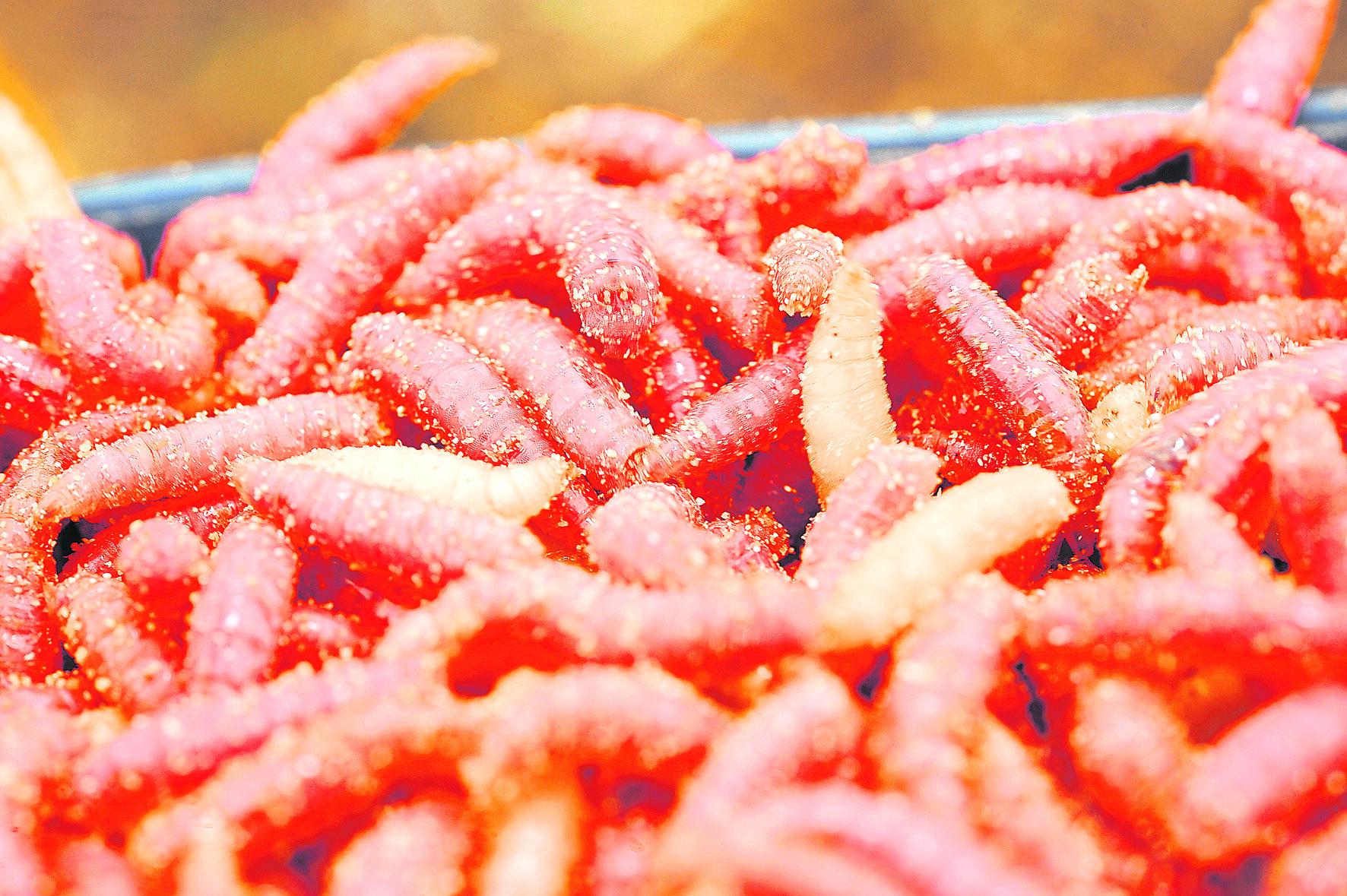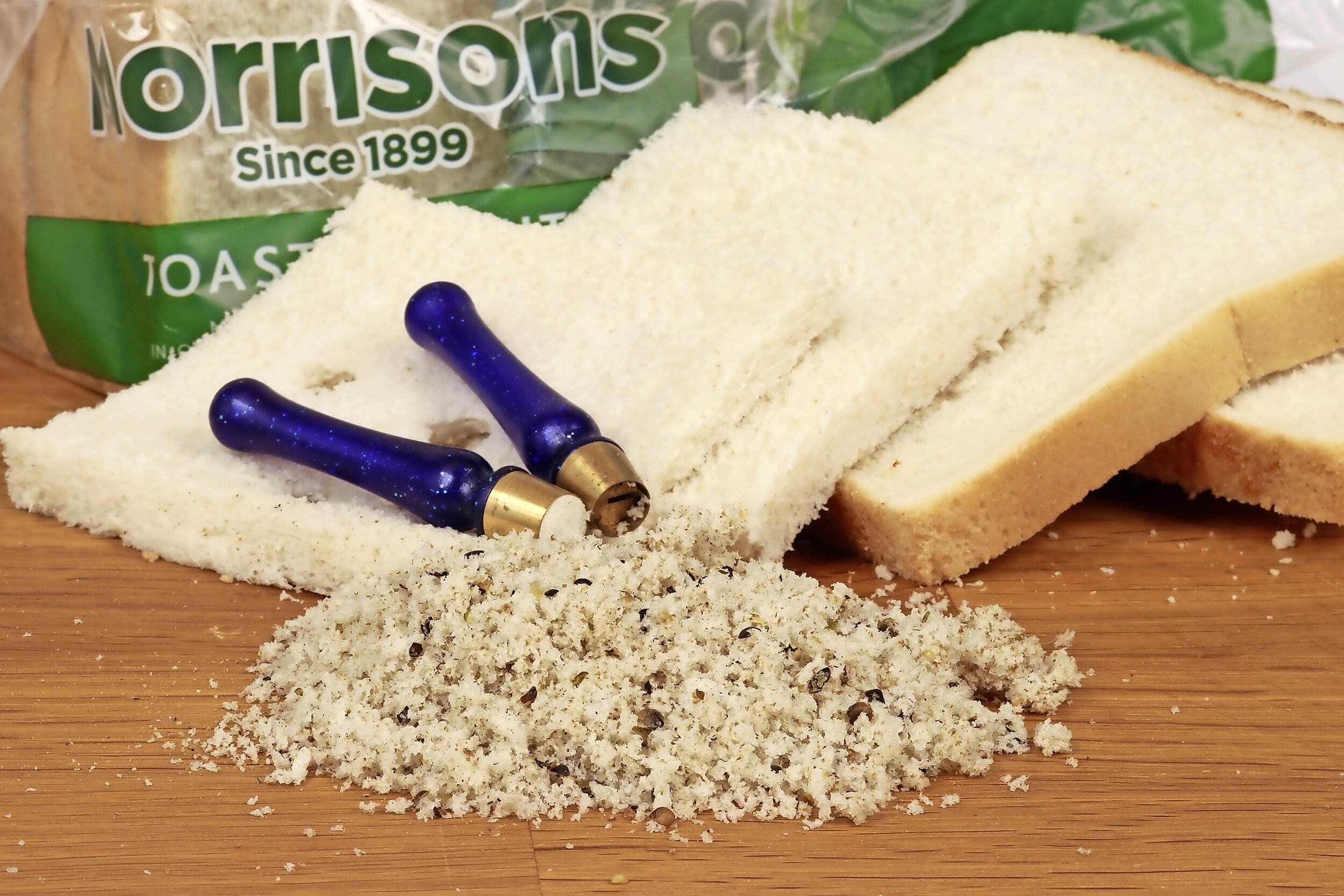A bait combination for every species with bait expert Dr Paul Garner
The bait you load on to your feeder can make a massive difference to the fish you catch. Here are some of my favourite combinations...
The Method is super-effective for big greedy carp. Recast regularly at the start of a session to lay down a bed of feed, and use a groundbait containing flaked maize, small pellets and other morsels to keep carp grubbing around. Top this off with a shaved 15mm wafter boilie on the hair.
Commercial carp respond well to feed pellets. The bulk of my feed will be 4mm pellets, but to stop the carp getting fixated on these I’ll add a handful of 6mm pellets to the mix. Start with an 8mm banded pellet but be prepared to switch to a larger or smaller bait
Fishmeal pellets with a Method feeder are deadly for bream. I combine sweet and fishmeal elements in all my bream mixes. Sticky pellets, softened with molasses-flavoured water, are a great starting point for bream at range, with pellet, mini-boilie and hair-rigged worm hookbaits.
My light, high-attract groundbait is low in food value – Dynamite Swim Stim Green with added Krill or crayfish powder as a stimulant. On the hook use corn for tench, while for crucians give a 6mm soft pellet, a rubber caster or a bunch of dead maggots a try.
On lakes that get lots of carp bait the roach and rudd will see a Method load as an easy meal. With a 10mm boilie on the hair, load the feeder with a 50-50 mix of dark fishmeal goundbait and brown crumb. For rudd I swap a boilie hookbait for a pop-up fished 4ins-6ins off the deck.
Dr Paul Garner's 10-minute make | Preparing chickpeas
Chickpeas make a great pre-baiting ingredient and they’re not expensive. You need to prepare them properly though. Here’s how I do mine…
Cover a pint of dry chickpeas with two pints of water in a bait tub.
Add about a teaspoonful of red dye. This will darken the bait down and make it blend in better.
Add a teaspoonful of Scopex No.1 flavour and half a teaspoonful of intense sweetener or Betalin sweetener.
Leave in the fridge overnight so that the chickpeas will be completely rehydrated. The flavour and colour will be drawn right into the bait.
Bargain basement baits
The bait we use can be a big outlay for all of us, especially when faced with venues full of hungry carp, but do you really have to spend a fortune on expensive offerings, or are cheaper alternatives just as good? This week I take a look at some of the bargain basement baits that are out there.
Cut the waste
I am just as guilty as the next man of taking far too much bait with me, especially when faced with a venue that I am unfamiliar with. I just don’t want to turn up and find that people are bagging-up on a bait that I haven’t got in my bag.
To combat this problem, check out the venue’s website or maybe give them a ring before your trip. Most of the time you can get some useful and up-to-date information on what is working.
Even if you have sparse information about the venue, other than the species you’re after and the tactics you’re going to use, you can still use this to cut down on bait expenses. I find it better to put ‘all my eggs in one basket’ and go with a clear plan of how I am going to fish with just one or two baits, than take too many.
Rarely do I find that I have too little of a certain bait with me, so think carefully about how much you need, or use baits that can be saved until your next trip if they go unused. This can save a lot of waste and cut your costs too.
Here are some of the cheapest baits around, but ones that will still catch an awful lot of fish...
Often overlooked, bread is a fantastic commercial bait, and one that will catch a range of different species. At this time of the year try punching a slice of bread and pinching the 8mm disk around the shank of the hook. Bread has the obvious advantage of being highly visible, and also very light and fluffy, making it ideal on days when the fish are not feeding confidently.
Also, try fishing bread over groundbait, as the light texture of the hookbait resembles the fine particles of feed. To bulk out your groundbait, mix it as normal and then add an equal amount of finely-liquidised bread to achieve a rich feed that will break down quickly and form a carpet of bait.
We really overlook cheese baits in the UK, but go over to the continent and cheese-flavoured baits are among the best-sellers. Some of the pre-packaged ‘snack’ cheeses have a great consistency and strong flavour that singles them out as top hookbait choices. Best of all, they are cheap.
If you have a meat cutter then this will make short work of rubbery blocks of cheese, turning them into the perfect size for both the hook and for feed. Cheese really is a brilliant carp bait, and if you punch smaller pieces you will be surprised at what other fish species you will catch too!
Meat can be quite an expensive bait, but by shopping around you can find some real bargains, and because it is rather filling, most of the time you will only need a relatively small amount.
Garlic sausage is one of my favourite meat baits, as it has the perfect soft texture, but stays on the hair well. You can find it on the deli counter of your local supermarket. The strong aroma is also a noted carp and bream attractor, and in recent seasons small pieces of meat have caught me a wide range of different species.
Cut the sausage into 10mm thick slices and then use an 8mm meat punch to produce hookbaits that can easily be hair-rigged. Once I have punched out as many baits as possible I break up the remnants and use this as my loosefeed.
I like to use a soft paste, which is ideal for fishing either on the pole or on a long float rod down the edge. A more selective bait than my other choices, paste often sorts out the bigger carp and will also pick up bream and tench. Buy bulk bags of paste, as you only need to mix up as much as you need and the rest will keep for future trips. Go for a fishmeal-based bait at this time of the year.
You can make paste out of your favourite groundbait too. Just mix it quite wet and it will bind together well enough to be carefully swung out for margin fishing. If you want a tougher paste then instead of using water, mix the dry powder with an egg as this will bind it together much more firmly.
Dr Paul Garner's potato hookbaits
I suppose you could say that potato hookbaits really are as cheap as chips! While not suitable as feed, potato can easily be cut into slices and punched to make a tough hookbait. Better still, it takes on colours and flavourings readily, making it a very low-cost, easy-to-use alternative to other hookbaits.
Cut a potato into 10mm thick slices using a sharp knife. There is no need to remove the skin.
Use a bait punch to produce your plain hookbaits. Punches of 10mm and above work best with this quite tough bait.
Add a teaspoonful of Strawberry flavouring and half a teaspoonful of red dye, and shake well so that the baits are evenly covered.
After a few minutes the potato will have absorbed the colour and flavour. For best results, leave overnight in the fridge.
Potato baits are easy to hair-rig and are long-lasting, making them ideal for use with the Method feeder.
Six easy steps for using corn
There are few cheaper and more effective baits for commercial fishery carp at this time of year than sweetcorn. A large tin from the supermarket will set you back less than a pound, but it can provide enough bait to last the best part of a session. Corn is highly effective for a number of reasons, and high on that list is its bright colour and softness, especially when compared to a 6mm pellet or a cube of meat.
The colour makes corn stand out when fished on its own or over a bed of another feed, while its softness is much loved by all fish. It’s also not particularly filling, as a grain of corn boasts a high water content so carp can trough away for hours without getting full. It’s also brilliant for other species, with bream, tench and even quality roach all loving the yellow stuff!
Try sweetcorn on different colours
In its natural form, corn is bright yellow, and that’s perhaps the main reason for its effectiveness. Even in coloured water, fish can easily pick out a grain, and if the lake is slightly clear, this ‘high-viz’ quality comes even more to the fore. However, you can buy corn in different colours and flavours, and on some waters red corn will outfish yellow. If you’re not sure which colour to use, arm yourself with a variety and keep changing on every cast until you catch – even green corn can have its day!
Big hooks
Compared to a maggot or a pellet, corn is a big bait, so you need to match the size of the hook accordingly. On the strike, the hook will pull through a soft piece of corn but you’ll need to be able to mount the bait properly so it stays on during the cast. Pick a hook with a wide gape as this will allow the bait to sit comfortably on the bend, while leaving a decent amount of the hookpoint on show. This will aid hooking when the float goes under. In terms of hook size, a 14 or 16 will be just about perfect.
Choose the right floats
Corn is quite a heavy bait, so this means you have to think big when it comes to floats, especially when fishing in open water. If your float is too light then the presentation will be unbalanced, and the fish will sense this. On the pole, pick a float with quite a big body, such as a rugby ball or diamond shaped one of 0.5g to 0.7g, dependent on the depth. When fishing the margins this can be smaller, but certainly no finer than a 4x12 pattern. Shot this with a bulk and one dropper shot and set the rig so that the corn is just resting on the bottom.
Combine it with other baits
Fished on its own, corn is deadly, but it can be improved by feeding it with other baits. Hemp is brilliant when fed to create a bed on the bottom, over which corn hookbaits are fished to really stand out. Cubed 6mm meat is another winner at this time of year, mixed 50/50 with corn as feed. You can also pop a few grains into chopped worm and caster feed and this will give you the option of changing from a worm hookbait to a piece of corn if small fish are a problem.
Hooking Corn
There is a right way to hook corn, and although you can simply nick the hook through the side, it will eventually work loose and be hanging on by a thread. The best way to mount a grain of corn is to pierce it through the rounded end and work the hook down the grain so it comes out of the flattened bottom end. This ensures that all of the shank and most of the bend is inside the grain, leaving just the hookpoint on show. Using double corn also adopts the same principle.
Give it a go in shallow water
Should you be faced with fishing the far side of a snake lake or a shallow margin, corn can be transformed into a superb shallow-water feed. All it needs is a food blender to whizz the corn about for a few seconds to chop it into smaller pieces. When fed, it’ll create a lingering cloud, while the larger pieces will sink that bit slower. You can even go the whole hog and blend the corn into a sloppy soup that’ll put a bigger cloud into the swim. This works particularly well if the fish are feeding off the bottom.
Paul Garner's 10 minute fizzy boilies
There are several things that you can do to increase the pulling power of your hookbaits, drawing carp towards them and stimulating them to feed. In tests I have found that this can make a massive difference to catches, often doubling the number of fish netted. Try making these fizzing hookbaits that carp really can’t ignore.
Step 1)
Add a teaspoonful of boilie dip to your chosen hookbaits.Agitate and leave for as long as you can for it to soak in.
Step 2)
Add another teaspoonful of flavour, followed by a powder such as super-sweet pH trigger. Roll the baits to cover.
Step 3)
Repeat step two as many times as you like, building up layers of soluble attraction around the hookbaits.
Step 4)
Coating the lead with the same liquid and powder combo will create a slick of attraction right through the water column.






































